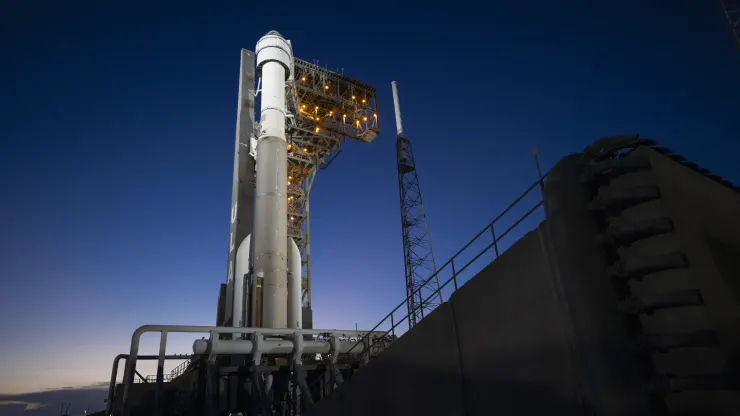Boeing Starliner launch, NASA Starliner mission, Starliner helium leak, Starliner Crew Flight Test, Starliner astronauts, Boeing and NASA, Starliner launch date, International Space Station, ISS missions, Commercial Crew Program
Discover how Boeing and NASA are advancing with the Starliner astronaut launch despite a helium leak in the spacecraft’s propulsion system. Learn about the mission details, scheduled launch dates, and the significance of this test flight for future space exploration.
Boeing and NASA are moving forward with the planned launch of the Starliner capsule, set to carry U.S. astronauts for the first time, despite a stable helium leak in the spacecraft’s propulsion system. This decision, announced during a press conference, underscores the confidence both organizations have in their ability to manage the issue without compromising flight safety.

Mark Nappi, Boeing’s vice president and manager of the Commercial Crew program, addressed the leak’s specifics during the press conference. He stated, “We are comfortable with the causes that we’ve identified for this specific leak. We know we can manage this [leak], so this is really not a safety of flight issue.”
Scheduled Launch and Backup Dates
The Starliner’s first crewed launch is now targeted for June 1, with backup opportunities on June 2, June 5, and June 6. This mission, known as the Starliner Crew Flight Test, is a significant milestone as it aims to deliver a pair of NASA astronauts to and from the International Space Station (ISS), marking the final major development test before commencing routine missions.
Historical Delays and Competition
Starliner’s crew debut has faced multiple delays over the years. Meanwhile, SpaceX’s Dragon capsule has been regularly flying astronauts for NASA since 2020 under the Commercial Crew program. Boeing has incurred significant costs due to these setbacks, with expenditures amounting to $1.5 billion in addition to nearly $5 billion of NASA development funds.
The latest attempt to launch the Starliner on May 6 was called off just two hours before liftoff due to an issue detected with the Atlas V rocket, which is built and operated by United Launch Alliance (ULA), a joint venture of Boeing and Lockheed Martin. Following this postponement, a small helium leak was identified, prompting new assessments of the capsule’s safety.
Assessing and Managing the Leak
During the press conference, NASA Associate Administrator Ken Bowersox and Steve Stich, NASA’s Commercial Crew Program manager, provided insights into the helium leak issue. Bowersox noted, “It’s taken a while for us to be ready to discuss [the helium leak problem]. It’s so complicated. There’s so many things going on. We really just needed to work through it as a team.”
Stich explained that the source of the leak is believed to be a seal in one of the spacecraft’s helium propulsion system flanges. Importantly, testing conducted after the May 6 postponement indicated that the leak rate remained stable. “We don’t expect the other [seals] to leak, and I think that’s a confidence that we have,” said Stich.
He emphasized that NASA has previously flown vehicles with small helium leaks, including missions involving the Space Shuttle and SpaceX’s Dragon. This historical precedent provides additional confidence in managing the current situation with Starliner.
Next Steps and Safety Reviews
NASA, Boeing, and ULA are planning another review on May 29 to assess the leak further. If all goes according to plan, they will roll the rocket and capsule out to the launch pad on May 30 in preparation for the June 1 attempt. This series of evaluations and preparations highlights the rigorous safety measures in place to ensure a successful mission.
The Starliner Crew Flight Test represents a crucial step forward in NASA’s Commercial Crew Program, aimed at restoring and maintaining the United States’ capability to launch astronauts into space from American soil. The success of this mission will not only validate Boeing’s Starliner capsule but also pave the way for future collaborations and advancements in space exploration.
Implications for Future Missions
Should the Starliner Crew Flight Test proceed as planned and demonstrate the capsule’s reliability and safety, it will mark a significant achievement for Boeing and NASA. This milestone will reinforce the United States’ position in human spaceflight and provide NASA with an alternative to SpaceX for transporting astronauts to the ISS. Having multiple providers increases resilience and flexibility for NASA’s missions.
Moreover, successful completion of the test flight will likely expedite Boeing’s transition to routine missions, potentially leading to more frequent and cost-effective access to space. This could open up new opportunities for scientific research, commercial ventures, and international partnerships aboard the ISS.
Conclusion
Despite the helium leak, Boeing and NASA’s decision to proceed with the Starliner launch underscores their confidence in the spacecraft’s safety and reliability. The meticulous analysis and testing conducted post-May 6 postponement have equipped both organizations with the necessary assurance to move forward. The upcoming Starliner Crew Flight Test, scheduled for June 1, stands as a testament to their commitment to advancing human space exploration and ensuring the safety and success of their missions. As the launch date approaches, all eyes will be on the Starliner capsule, eagerly anticipating a successful journey to the ISS and a new chapter in American spaceflight.
Read More-